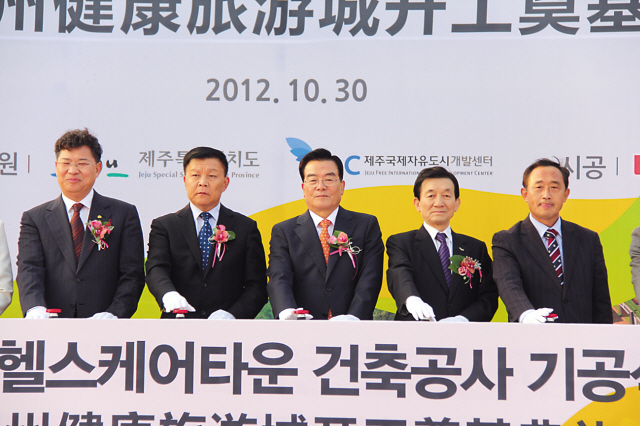SEOGWIPO, Jeju ― An hour’s drive south from the island’s main airport, there is an expanse of flat land with nothing but pebbles and sand.
To its north stands Hallasan, Korea’s tallest mountain, while the ocean can be seen just a few feet to the south.
The site seems perfect to build a town for tourists seeking medical treatment while on holiday, especially after one has seen the area’s sunsets.
This is where Jeju Free International City Development Center, or JDC, plans to develop a 1.5 square-kilometer healthcare town in an effort to become a medical tourism hub. JDC is a state-run enterprise of Korea’s Ministry of Land, Transport and Maritime Affairs.
 |
JDC chairman Byon Jong-il (second from right) presses a button with Chinese officials including Greenland chairman Chang Ok-ryang (left) to break ground for a new healthcare town in Seogwipo, Jeju, on Tuesday. (JDC) |
It has already attracted some $1 billion from Greenland Group, China’s state-run real estate conglomerate based in Shanghai, to build various facilities, including a mall, a medical R&D center and condos that will take up 778,000 square meters here by 2015.
This marks the first time for the Chinese company, whose real estate portfolio consists mostly of skyscrapers and business centers, to take part in health-related construction projects.
Its investment comes amid an increasing number of Chinese tourists to Jeju, which had already surpassed 500,000 this year as of August. Jeju’s annual target number of foreign tourists is 1 million.
“We see that this medical and leisure town will suit incoming Chinese as well as Koreans, and contribute to Jeju’s economy,” said Greenland chairman Chang Ok-ryang.
Also, Jeju’s natural beauty and the close distance between Shanghai and Jeju were other reasons the Chinese real estate giant decided to invest a 100 percent stake in the healthcare real estate assets.
Greenland’s investment is also JDC’s first foreign direct investment in the potential town, as well as its biggest FDI.
Jeju said this is just the beginning as it gears up to secure more large foreign investment to realize its ambition to make Seogwipo an international city.
“We are going to further seek large foreign investments equivalent to the size of Greenland’s $1 billion to build this town,” said JDC chairman Byon Jong-il.
Byon added that there is no specific deadline as to when Jeju will build the healthcare town.
“This is something we will have to continuously develop going forward,” he said.
Since the island was designated Jeju Free International City in 2002, JDC has been mapping out a plan to further promote tourism, Jeju’s main growth driver.
Its plan called for the establishment of not only a healthcare town, but also a science park where some 80 IT and biotech firms, including Daum, Korea’s second-largest search engine, and museums are currently stationed.
However, it does face challenges in promoting Jeju as an international tourism destination with health-care and science attractions, observers said.
Globally, Hong Kong and Singapore are doing the same.
Locally, Korea’s restrictions on establishing private hospitals make it hard for JDC to bring in a private foreign hospital. Singapore, for instance, allows such hospitals to open in the city-state. Korea prohibits such a move, reasoning that hospitals should be operated mainly in the interest of the public’s well-being rather than profit.
JDC signed a non-binding memorandum of understanding with Seoul National University Hospital in 2008, but nothing has developed since.
However, JDC chairman Byon said he sees Greenland’s first investment in its healthcare town as a ray of hope that will help move its project forward.
By Park Hyong-ki (
hkp@heraldcorp.com)







![[Today’s K-pop] Blackpink’s Jennie, Lisa invited to Coachella as solo acts](http://res.heraldm.com/phpwas/restmb_idxmake.php?idx=644&simg=/content/image/2024/11/21/20241121050099_0.jpg)
